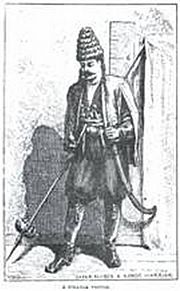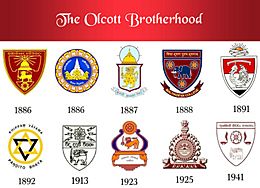Henry Steel Olcott facts for kids
Quick facts for kids
Henry Steel Olcott
|
|
|---|---|
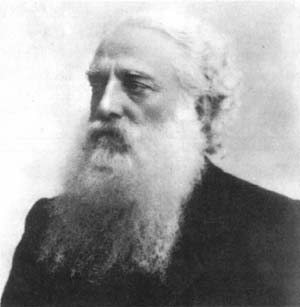
Colonel Henry Steel Olcott
|
|
| Born | 2 August 1832 |
| Died | 17 February 1907 (aged 74) |
| Nationality | American |
| Education | City College of New York Columbia University |
| Occupation | Military officer Journalist Lawyer |
| Known for | Revival of Buddhism Theosophical Society American Civil War |
| Spouse(s) | Mary Epplee Morgan |
| Signature | |
 |
|
Henry Steel Olcott (born August 2, 1832 – died February 17, 1907) was an American military officer, journalist, and lawyer. He was also a Freemason and helped start the Theosophical Society. He was its first president.
Olcott was the first well-known American of European background to officially become a Buddhist. As the president of the Theosophical Society, he helped bring back interest in studying Buddhism. People see Olcott as a Buddhist modernist because he explained Buddhism in a way that made sense to Western people.
Olcott played a big part in bringing Buddhism back to life in Sri Lanka. People in Sri Lanka still honor him for his efforts. They call him "one of the heroes in the fight for our independence and a pioneer of today's religious, national, and cultural revival."
Contents
Henry Olcott's Early Life and Career
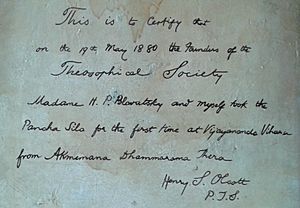
Henry Steel Olcott was born on August 2, 1832, in Orange, New Jersey. He was the oldest of six children. His father, Henry Wyckoff Olcott, was a businessman, and his mother was Emily Steele Olcott. As a child, Henry lived on his father's farm in New Jersey.
When he was a teenager, Olcott went to the City College of New York and then Columbia University. He joined a student group called St. Anthony Hall. In 1851, his father's business failed, and Henry had to leave college.
While living in Amherst, Ohio, Olcott learned about spiritualism from his relatives. Spiritualism was a belief that people could talk to spirits. Olcott became very interested in topics like psychology, hypnotism, and psychometry. In 1853, he helped start the New York Conference of Spiritualists. He also wrote articles about spiritualism for a newspaper.
From 1858 to 1860, Olcott wrote about farming for newspapers. He also wrote about other topics sometimes. He was present when John Brown was executed.
In 1860, Olcott married Mary Epplee Morgan. They had four children, but two of them died when they were babies.
He served in the US Army during the American Civil War. After the war, he became a special officer for the War Department in New York. He was later promoted to the rank of colonel and moved to the Department of the Navy. He was well-respected and helped investigate the assassination of Abraham Lincoln in 1865.
In 1868, he became a lawyer. He specialized in cases about insurance, taxes, and fraud.
In 1874, Olcott heard about the séances of the Eddy Brothers in Vermont. Séances were meetings where people tried to communicate with spirits. Olcott was very interested and wrote an article about the Eddy family for a newspaper. His article was so popular that other newspapers printed it too. His book People from the Other World, published in 1874, was based on his early articles about the Spiritualist movement.
Also in 1874, Olcott met Helena Blavatsky while they were both visiting the Eddy farm. His interest in spiritualism and his new friendship with Blavatsky helped him develop his spiritual ideas.
Olcott continued to work as a lawyer even after the Theosophical Society was started. He also helped the new religious group financially. In 1875, some spiritualists asked Olcott to investigate if two mediums, Jenny and Nelson Holmes, were faking their spirit appearances.
In 1880, Helena Blavatsky and Olcott became the first Westerners to take the Three Refuges and Five Precepts. This is a special ceremony where someone officially becomes a Buddhist. Blavatsky was the first Western woman to do this. Olcott once said his adult faith was "pure, primitive Buddhism."
Starting the Theosophical Society
From 1874 onwards, Olcott's spiritual journey with Blavatsky and other spiritual leaders led to the creation of the Theosophical Society. In 1875, Olcott, Blavatsky, and others, like William Quan Judge, started the Theosophical Society in New York City. Olcott helped pay for the Theosophical Society in its first years. He was the president, while Blavatsky was the secretary.
In December 1878, they left New York to move the Society's main office to India. They arrived in Bombay on February 16, 1879. Olcott wanted to experience the home country of his spiritual leader, the Buddha. The Society's main office was set up in Adyar, Chennai. They also started the Adyar Library and Research Centre there.
While in India, Olcott worked to get translations of old Eastern texts. These texts were becoming available because Western researchers were studying them. He wanted to avoid Western ideas that might change the meaning. He aimed to find the true message of texts from Buddhist, Hindu, and Zoroastrian religions. This way, he could teach Westerners correctly.
Olcott's research and translation efforts connected him with early anthropologists and scholars of religion. He wrote many letters to Max Müller, asking questions about Hinduism and Buddhism. He also shared what he learned from his travels in South Asia. He met both Müller and Edward Burnett Tylor at least once at the University of Oxford.
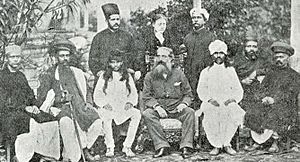
Olcott was most interested in Buddhism, and he is well-known for his work in Sri Lanka. After writing letters for two years with Sri Piyaratana Tissa Mahanayake Thero, Olcott and Blavatsky arrived in Colombo, the capital, on May 16, 1880. Helena Blavatsky and Henry Steele Olcott took the Five Precepts at the Wijayananda Viharaya in Galle on May 19, 1880. On that day, Olcott and Blavatsky were officially recognized as Buddhists. However, Olcott said they had already declared themselves Buddhists when they lived in America.
During his time in Sri Lanka, Olcott worked to bring Buddhism back to life in the area. He also gathered the main ideas of Buddhism to teach Westerners. During this time, he wrote the Buddhist Catechism (1881), which is still used today.
The Theosophical Society built several Buddhist schools in Ceylon (now Sri Lanka). Some of the most famous are Ananda College (1886), Dharmaraja College Kandy (1887), Maliyadeva College Kurunegala (1888), Mahinda College Galle (1892), and Nalanda College, Colombo (1925). Olcott also helped a committee design a Buddhist flag in 1885. This flag was later chosen as a symbol by the World Fellowship of Buddhists. It became the flag for all Buddhist traditions.
Helena Blavatsky later moved to London, where she died in 1891. But Olcott stayed in India and continued the work of the Theosophical Society there. Olcott remained president, and when Annie Besant joined, it started a new time for the movement. After Olcott died, the Theosophical Society chose Annie Besant to be the new president.
The Buddhist Catechism
What is the "Buddhist Catechism"?
Olcott's "Buddhist Catechism," written in 1881, is one of his most important contributions to bringing Buddhism back to life in Sri Lanka. It is still used there today. The book explains what Olcott believed were the main teachings of Buddhism. This includes the life of the Buddha, the message of the Dharma (teachings), and the role of the Sangha (community of monks and nuns). The book also talks about how the Buddha's message connects with modern society. People in South Asia and elsewhere saw Olcott as someone who helped revive Buddhism.
The book is written in a question-and-answer style, similar to how some Christian catechisms are structured.
Olcott's catechism shows a new way of understanding traditional Buddhist ideas, influenced by the Enlightenment. As David McMahan said, Olcott "connected Buddhism with scientific thinking." He also used ideas from "occult sciences" of the 1800s.
How Olcott Combined Science and Theosophy
The Theosophists wanted to combine religion and reason. They used spiritualism and science to study supernatural things. This "occult science" was used to find the "truth" behind all the world's major religions. Through their research, Olcott and Blavatsky decided that Buddhism best showed what they found important in all religions.
Olcott used scientific thinking when he explained Buddhism. This is clear in a chapter of his "Buddhist Catechism" called "Buddhism and Science." His efforts were some of the first to try and combine scientific understanding with Buddhist religion. He saw a connection between Buddhism and Science. This was similar to his Theosophical approach, which aimed to show the scientific reasons for supernatural events like auras, hypnosis, and Buddhist "miracles."
Olcott's Death and Lasting Impact
Olcott was the President of the Theosophical Society until he died on February 17, 1907.
Two major streets in Colombo and Galle are named Olcott Mawatha to honor him. A statue of him stands in front of the Colombo Fort Railway Station. Many other schools he helped start or that were founded in his memory have statues to honor his work in Buddhist education. Many Sri Lankans still remember him fondly today. On September 10, 2011, a statue of Colonel Olcott was put up at a Buddhist temple near Princeton, New Jersey.
The date of his death is often remembered by Buddhist centers and Sunday schools in Sri Lanka today. It is also remembered by Theosophical groups around the world. Olcott believed he was a savior for Asia, an outsider hero who would come to save the continent from spiritual decline.
His efforts to bring Buddhism back to life in Sri Lanka were successful. They influenced many local Buddhist thinkers. At that time, Sri Lanka was controlled by the British. Many Buddhists felt that Olcott's explanation of the Buddha's message gave them social motivation. It supported their efforts to push back against colonial attempts to ignore Buddhism. David McMahan wrote that "Henry Steel Olcott saw the Buddha as someone like an ideal liberal thinker – full of 'kindness,' 'thankfulness,' and 'tolerance,' who promoted 'brotherhood among all men' and 'lessons in manly self-reliance.'" His Western view of Buddha influenced Sri Lankan leaders like Anagarika Dharmapala.
Olcott and Anagarika Dharmapala worked together. This shows that both men understood the differences between East and West. Olcott helped pay for Buddhists to attend the World Parliament of Religions in Chicago in 1893. Including Buddhists in the Parliament helped Buddhism grow in the West, especially in America. This led to other modern Buddhist movements.
Olcott was probably the only major person who helped revive Sinhalese Buddhism in the 1800s who was born and raised in the Protestant Christian faith. However, he had left Protestantism for Spiritualism long before he became a Buddhist. Because of his Protestant childhood, many scholars call the type of Buddhist modernism he influenced "Protestant Buddhism."
Henry Olcott's Books
- Sorgho and Imphee, the Chinese and African sugar canes; 1857
- Outlines of the first course of Yale agricultural lectures; 1860
- Descendents of Thomas Olcott, 1872
- Human Spirits and Elementaries; 1875
- People from the other world; 1875
- A Buddhist catechism; 1881
- Theosophy, Religion, and Occult Science; 1885
- Old Diary Leaves (6 volumes), 1895
- The Hindu Dwaita Catechism; 1886
- The Golden Rules of Buddhism; 1887
- The kinship between Hinduism and Buddhism; 1893
- The Poor Pariah; 1902
- The Life of the Buddha and its Lessons; 1912
- The Spirit of Zoroastrianism; 1913
- Old diary leaves, Inside the occult, the true story of Madame H. P. Blavatsky; 1975 (reprint)
See also
 In Spanish: Henry Olcott para niños
In Spanish: Henry Olcott para niños
- Buddhist flag
- Anagarika Dharmapala
- Buddhist modernism
- Buddhism in Sri Lanka
- Theosophy and Buddhism


